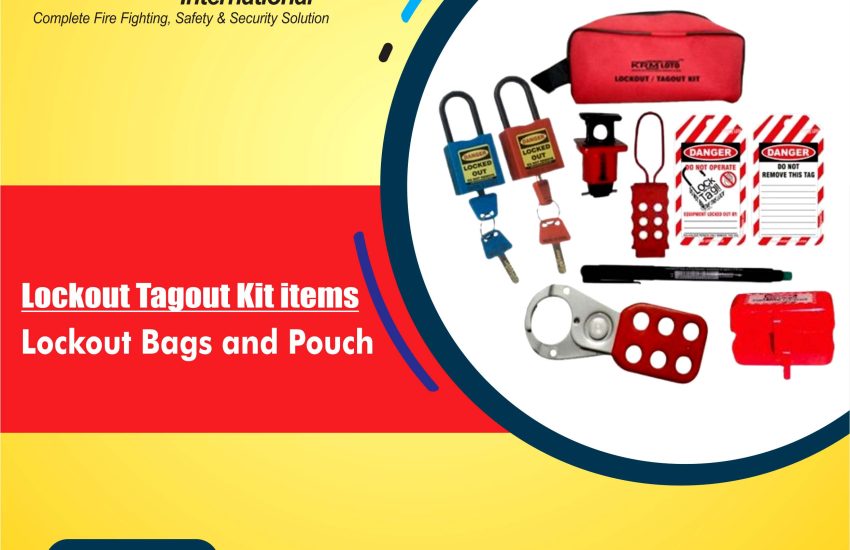Lockout Bags and Pouches play a key role in ensuring workplace safety during maintenance or repair tasks. These storage solutions help organize and manage lockout/tagout (LOTO) devices, making them secure, accessible, and ready for use. In this guide, we will explain the importance of lockout bags and pouches, their features, types, and why they are crucial for maintaining workplace safety.
What Are Lockout Bags and Pouches?
Lockout bags and pouches serve as portable storage for lockout/tagout devices such as locks, keys, tags, and other safety equipment. They keep all materials organized and accessible during equipment shutdowns, allowing workers to perform maintenance tasks safely. These bags are designed for durability, with clear labeling and multiple compartments for easy identification and storage.
Why Are Lockout Bags and Pouches Important?
Lockout/tagout procedures are essential for preventing accidents caused by the accidental release of hazardous energy. Lockout bags and pouches support these procedures by ensuring that:
- Devices Are Easy to Access: Workers can quickly retrieve the necessary lockout devices.
- Compliance Is Maintained: Proper storage helps companies comply with OSHA regulations, such as 29 CFR 1910.147 for Lockout/Tagout.
- Organization and Efficiency Are Improved: Lockout bags help organize equipment, reducing downtime and improving efficiency during maintenance.
- Devices Stay Secure: These bags protect lockout devices from damage, loss, or tampering, ensuring they work as intended.
Types of Lockout Bags and Pouches
Several types of lockout bags and pouches are available, each designed to meet different needs. Here are some of the most common types:
1. Standard Lockout Bags
Standard lockout bags are large enough to store multiple lockout devices, keys, and tags. These bags often feature zippered closures, adjustable straps, and durable construction. They are ideal for larger workplaces or teams that need to store a variety of lockout equipment.
2. Lockout Pouches
Lockout pouches are smaller and more compact. They are designed to hold a few essential items, such as a single lock, key, or tag. Pouches are perfect for individuals or small teams who need quick access to their lockout equipment.
3. Heavy-Duty Lockout Bags
Heavy-duty lockout bags are made with extra-durable materials like high-strength nylon or PVC. These bags are perfect for harsh or industrial environments where they need to withstand frequent use or extreme weather conditions.
4. Clear Lockout Bags and Pouches
Clear lockout bags feature transparent or semi-transparent windows, allowing workers to view the contents without opening the bag. This feature helps verify that all necessary devices are in place. Additionally, clear bags aid in inventory management by providing quick visual checks.
5. Lockout Kits and Combination Bags
Some lockout bags come as part of a lockout kit, which includes a variety of devices, tags, and personal protective equipment (PPE). These kits are pre-organized, ensuring workers have everything they need. Combination bags usually offer larger storage capacities and multiple compartments for better organization.
Key Features to Look for in Lockout Bags and Pouches
When selecting lockout bags and pouches, consider these essential features:
- Durability: Choose bags made from tough materials such as nylon, vinyl, or PVC to ensure long-lasting use.
- Multiple Compartments: Bags with separate compartments make it easier to keep lockout devices organized and easy to find.
- Zipper or Velcro Closures: Secure closures prevent accidental spills or loss of items.
- Carrying Handles and Straps: These features make the bags easier to transport throughout the workplace.
- Color Coding: Brightly colored bags, like red or yellow, are commonly used for lockout/tagout procedures. This makes it easier to identify them.
- Labeling and Clear Windows: Bags with clear labeling or windows allow workers to quickly identify the contents.
Benefits of Using Lockout Bags and Pouches
Using lockout bags and pouches provides several key benefits, including:
- Improved Workplace Safety: Lockout bags keep safety equipment organized and accessible, reducing the chances of accidents during maintenance.
- Faster Emergency Response: In emergency situations, lockout bags allow workers to access the necessary devices quickly, preventing delays.
- Increased Compliance: Properly storing lockout equipment helps businesses meet OSHA standards and avoid penalties for non-compliance.
- Cost-Effectiveness: Storing devices properly prevents damage or loss, which ultimately saves money.
- Convenience: Lockout bags make it easier for employees to transport safety equipment, improving workflow and efficiency.
Conclusion: Invest in Lockout Bags and Pouches for Workplace Safety
Lockout bag and pouch are essential tools for maintaining safety during equipment shutdowns, maintenance, and repairs. Businesses can choose the right lockout bags based on their size, features, and needs. By investing in these bags, companies ensure lockout/tagout procedures are followed efficiently, preventing accidents and injuries caused by hazardous energy.
Organizing lockout devices and securing them in reliable bags also promotes a culture of responsibility and safety in the workplace. These bags help improve the overall safety of maintenance operations and contribute to a more efficient work environment.
Frequently Asked Questions (FAQs)
Q1: Are lockout bags and pouches reusable?
Yes, lockout bag and pouch are designed for repeated use. With proper care, they can last for years.
Q2: Can lockout bags hold all types of lockout devices?
Lockout bags come in various sizes and configurations, so they can accommodate different types of lockout devices such as locks, tags, keys, and hasps.
Q3: Are clear lockout bags better than opaque ones?
Clear lockout bags provide better visibility of the contents, making inventory checks easier and faster. However, opaque bags may offer more privacy for sensitive equipment.


